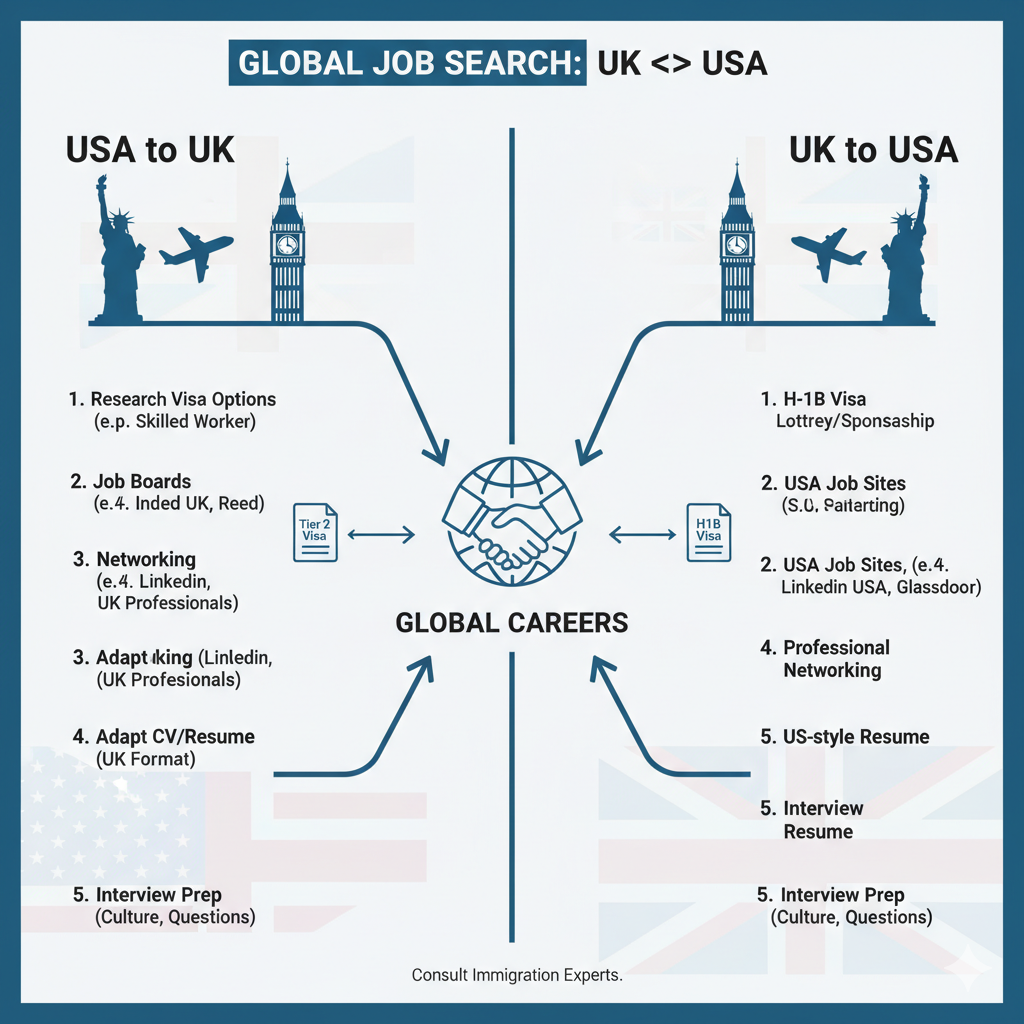Global careers are no longer a dream reserved for a few. With today’s interconnected job market, many professionals want to move across the Atlantic—either how to Get a Job in the UK from USA and how to Get a Job in the USA from UK. However, this journey is not straightforward. It involves understanding visa rules, employer sponsorships, job market dynamics, and cultural differences.
This guide covers both pathways:
- How to get a job in UK from USA
- How to get a job in USA from UK
Each section includes steps, tips, challenges, and links to useful resources.
Part 1: How to Get a Job in the UK from USA
If you are living in the United States and aiming to move to the United Kingdom for work, here’s what you need to know.
1.1 UK Work Visas and Permits
The first step in securing a job in the UK is to make sure you can legally work there. Without the right visa, no employer will move forward with your application.
The main UK work visa options include:
- Skilled Worker visa – This is the most common route. You’ll need a confirmed job offer from a UK employer who is licensed to sponsor foreign workers.
👉 Apply for Skilled Worker Visa (GOV.UK) - Health and Care Worker visa – For doctors, nurses, and social care workers.
👉 Health and Care Worker visa (GOV.UK) - High Potential Individual (HPI) visa – For graduates from top global universities.
👉 UK HPI Visa info (Pacific Prime) - Other visas – Graduate visa, UK Ancestry visa, or Youth Mobility Scheme (if eligible).
👉 UK Work Visas Overview (GOV.UK)
Tip: Check if the employer is a licensed sponsor here: UK Sponsor List.
1.2 Job Search Strategy
Getting a job in the UK from the USA is highly competitive. Here’s how to approach it:
- Target employers that sponsor visas – Many UK companies clearly state whether they offer sponsorship.
- Use UK job boards – Popular platforms include Indeed UK, Reed, Totaljobs, and LinkedIn.
- Network online – Join UK-based professional groups, alumni associations, and LinkedIn communities.
- Filter for sponsorship jobs – Some portals allow you to filter roles that specifically mention “visa sponsorship.”
👉 Expatica has a useful guide: Finding jobs in the UK.
1.3 Application and Hiring Process
To maximize your chances:
- Tailor your CV to UK standards – The format differs from American résumés.
- Write a strong cover letter – Be transparent about requiring visa sponsorship.
- Contact HR directly – Sometimes recruiters overlook international applicants unless you reach out.
- Prepare for UK-style interviews – These often focus on competency-based questions.
1.4 After the Job Offer: Visa Application Steps
Once you secure a job offer:
- Employer issues a Certificate of Sponsorship (CoS).
- You apply online for a Skilled Worker visa.
- Submit required documents: passport, job offer, proof of English proficiency, etc.
- Provide biometrics at a Visa Application Centre.
- Wait for processing (usually about 3 weeks).
👉 Full details here: Apply for Skilled Worker Visa (GOV.UK).
1.5 Challenges
- Many UK employers prefer candidates with prior UK experience. A Reddit discussion confirms this bias:
“Most UK recruiters prefer a candidate with UK experience. They make it really hard for someone that’s not originally from the UK to gain their first UK experience.” (Reddit Career Questions UK) - Sponsorship is costly for employers, so they are selective.
- Competition is intense, especially in fields like IT and finance.
- You may need professional certifications recognized in the UK (e.g., ACA vs CPA for accounting).
1.6 Useful Links for Americans Seeking UK Jobs
- GOV.UK – Work visas
- GOV.UK – Skilled Worker Visa
- Indeed UK – Work in UK for Foreigners
- Expatica – Jobs in the UK Guide

Part 2: How to Get a Job in the USA from UK
Now let’s flip the situation. Many UK citizens (or residents) want to move to the USA for work. Here’s how you can do it.
2.1 US Work Visas
Unlike the UK, the US has limited pathways for foreign workers. Key visas include:
- H-1B (Specialty Occupations) – For skilled professionals (IT, engineering, finance, healthcare). Requires employer sponsorship.
👉 H-1B Visa info (USCIS) - L-1 (Intra-company Transfer) – If you already work for a multinational company with offices in the US.
- O-1 (Extraordinary Ability) – For individuals with exceptional achievements in science, arts, education, or business.
- Green Card (EB-2, EB-3 categories) – Permanent employment-based visas.
👉 Employment-based immigrant visas (Travel.State.Gov) - Temporary visas – H-2B for seasonal non-agricultural jobs.
👉 H-2B Visa info (USCIS)
2.2 Job Search Strategy
If you’re wondering how to get jobs in USA from UK, here are the best approaches:
- Use sponsorship-focused job boards:
- Apply to large companies – Tech giants (Google, Amazon, Microsoft, IBM) and healthcare providers frequently sponsor visas.
- Networking – The US job market relies heavily on referrals. Use LinkedIn, professional associations, and conferences.
- Look into internships or remote contracts first – These can sometimes lead to a full-time sponsored role.
2.3 Application and Hiring Process
- Apply for jobs that explicitly mention “visa sponsorship.”
- Secure a job offer.
- Employer files Form I-129 Petition for a Nonimmigrant Worker with USCIS.
👉 Form I-129 Info (USCIS) - Once approved, attend an interview at the US Embassy/Consulate in the UK.
- Receive your visa, then move to the US.
2.4 Challenges
- Visa caps – For example, H-1B visas are subject to an annual lottery.
- High costs for employers – Many US companies hesitate to sponsor international candidates unless skills are rare.
- Timing – H-1B applications must align with USCIS filing deadlines.
- Competition – You’ll be competing with both US workers and other international candidates.
2.5 Useful Links for UK Citizens Seeking US Jobs
- USCIS – Temporary Workers
- USCIS – H-1B Specialty Occupations
- Indeed – Visa Sponsorship Jobs USA
- USponsorMe – Jobs in USA for foreigners
Conclusion
Whether you’re figuring out how to get a job in UK from USA or searching how to get a job in USA from UK, the process requires planning, patience, and persistence.
- For the UK, focus on Skilled Worker visas, target companies that sponsor, and adapt your CV to UK standards.
- For the USA, explore H-1B, L-1, and O-1 visas, apply to global companies, and leverage networking.
Both routes demand flexibility, strong professional skills, and readiness to navigate strict immigration rules. While challenging, many professionals successfully cross the Atlantic every year—proof that with the right preparation, you can too.
Pro Tip: Bookmark official government websites (GOV.UK, USCIS) for the most updated immigration information. Immigration laws change often, and relying on third-party sites alone can lead to outdated guidance.


